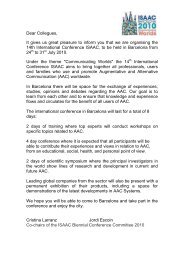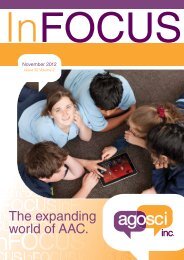articles articles36A Speech Pathologist at the 2020 Summit (cont)with the group of 25 in my sub-stream of early childhood andschooling. There were several others making similar argumentsfor putting resources into early childhood development suchas Professor Frank Oberklaid, a pediatrician from the RoyalChildren’s Hospital in Melbourne, who warned that it was a“pay now or pay later” question.There were many challenges such as convincing the other substreamswithin the Productivity stream that without an emphasison early childhood, there would be a much poorer outcome interms of numbers and skills of employable workers. The otherchallenges were condensing my point to make it punchy enoughto get across to politicians or people who don’t work in healthor childhood education. I was even lucky enough to have a chatwith Kevin Rudd who to his credit was interested in what it waslike working in schools “at the coalface”. I tried to stress theMountains and Molehills:The South Australian Statewide Complex Communciation Needs Projectby Janelle Sampsonsccn@novita.org.auDue to a generous allocation of South Australian StateGovernment funding, the diverse range of services requiredto fully support people with Complex Communication Needs(CCN) is fi nally on the map in South Australia.In 2007, the State Government announced funding for a periodof 12 months for the Statewide Complex Communication Needs(SCCN) project, managed through the NovitaTech Division ofNovita Children’s Services in South Australia. The aim of theproject is to enhance the communication opportunities andparticipation of people from 0-65 with CCN in South Australia.The expected outcomes of the project are:1. Assessment, prescription, provision and follow up ofcohesive and effective total augmentative communicationsystems for people with CCN.2. Development of community knowledge, skills and attitudesto support enhanced opportunities and participation ofpeople with CCN.3. Enhanced social networks for people with CCN.4. Investigation of potential service models to support thedevelopment of an ongoing, state-wide ‘community’ ofpeople with CCN, their caregivers and service providers.With much excitement and an equal amount of trepidation,I took on the role of Project Manager in November 2007. Iam completely aware that to achieve such aims and objectivesis a long term and complex process requiring a multitude ofpartnerships, programs and approaches. This is the mountainthat we face and with only 12 months of funding available itmay seem an impossible mission. However, for such a goodcause I was willing to give up any sense of control over mywork-life balance and take this on with the hope that we maycreate a foundation, or shall we say a molehill, on which toimportance of interactions between parents and children and ofallied health professionals such as speech pathologists in hisproposed “one stop shop” parent child centres. He seemed totake that on board but he was also interested in the size of myHECS debt!Another topic that deserved more of a mention that it receivedwas disabilities. There was a lot of emphasis on disadvantagebut this minority group didn’t seem to be a priority.All in all it was a very exciting peek at some of the workings ofgovernment. I do think our profi le as a profession needs raisingas it was hard work sometimes to help people to understandwhy a speech pathologist might be concerned with children’seducational outcomes. I was fortunate enough to come awaywith some contacts to pursue and a real sense of pride in ourprofession and our use of evidence as a base for what we do.build this mountain. In the past, services to people with CCNin South Australia have varied in terms of availability, fundingand expertise dependent on age, diagnosis and geographicallocation. It is hoped that even a molehill can seed a morecomprehensive and equitable approach to these much-neededservices.As I write this article, the project is approaching the half waypoint. This is a time to panic of course, but also to look at whatwe have accomplished and hope to still achieve. There are stillmany challenges ahead as well as future planning for servicesfor people with CCN at the completion of this project.Achievements to DatePersonally, my most important achievement to date as ProjectManager has been the recruitment of a dedicated and energeticteam. Without their understanding and acceptance of thischallenge, and their enthusiasm, even a molehill would beunachievable.As a team, we have placed our initial focus on the fi rst twoexpected outcomes listed above – communication solutionsand communication partner/service provider training. Thesewere the primary drivers of the funding and the most acute andpressing needs. From this, we are averaging 4-5 new referralsper week since the beginning of February, and 7-8 enquiriesper week to our information and advice service. Our currentreferral statistics show a predominance of male (82%) overfemale (18%) and an almost equal number of children (53%)to adults (47%). Primary referral groups in order of frequencyare people with Autism Spectrum Disorders, Motor NeuroneDisease, Cerebral Palsy, Stroke, Head Injury and IntellectualDisability. We are also receiving referrals from a diverse range
articles articlesMountains and Molehills... (cont)of service providers (11 different agencies to date) includingdisability agencies, schools, hospitals, not for profi t agenciesand community health services. The communication solutionsservice to date has been developed as a support to primarytherapists, rather than taking on clients individually. Thereasoning for this is that although many agencies are fi ndingit diffi cult to meet the demand for services, all clients eligiblefor the project are also eligible for services from an existingagency. If the SCCN Project were to take on clients without theinvolvement of these agencies there is potential for disconnectedand inequitable services, as well as contraindications to theprioritisation and workload management practices used bythese agencies. Additionally, it is more benefi cial to supporttherapists through the process of developing communicationsolutions for their clients with resources and/or expertise,rather than taking over. The aim of this is to build the capacityof existing agencies to provide more effi cient services duringand beyond the timelines of the SCCN Project.The trial and loan program has also shown a positive outcometo date. The project funding has allowed for a wide range ofcommunication equipment to be purchased or created (bothelectronic and non-electronic), that is available to clients andtherapists. Client loan is a priority; however there have beenmany requests for loan of the equipment by therapists forfamiliarisation, comparison and demonstration to their clients.The client loan of equipment is available in order to achieve acomprehensive trial prior to allocation for long term funding.During the trial period, SCCN can assist with:• modifications to the equipment• providing client and communication partner support• evaluation of the trial by the client, primary communicationpartners, and therapist.Following evaluation of the trial, equipment may berecommended (or not recommended), a different item may beloaned for trial, or an extension of the existing trial may benegotiated. Although there are only a small number of referralsat the point of equipment provision so far, this program hasalready resulted in a few changes to the type of equipment thatwas originally suggested.Several training and information sessions have been held todate and many more have been requested and scheduled.Recipients include people with CCN, their communicationpartners, service providers, allied health students and thegeneral public.We have also completed two additional grant applications forprograms that will support people with CCN but were not listedas our core deliverables for the project this year.Other Project PlansAlthough our focus to date has been on communication solutions,equipment, and information/advice services, we are eager toallocate time to capacity building activities. These capacitybuilding activities will focus on training for communicationpartners and service providers, resource development, socialnetworking events and public awareness activities. One part ofthis is a joint initiative with AGOSCI SA to establish an AAC(augmentative and alternative communication) Special InterestGroup, the fi rst of which is scheduled for the end of April<strong>2008</strong>. Resource development will also be particularly importantas these resources may be useful and time saving to othersbeyond the life of the project. Social networking events will beorganised based on the Club Yackety Yack model developed byNovita Children’s Services but with a wider eligibility criteriaand age range.]ChallengesClearly the biggest challenge has been the time limitationsof the project. The impact of this are the decisions we mustmake about which tasks are must haves, highly desirable, orjust benefi cial to have. We must consider not only the needsof the here and now, but how to allocate our time to ensurethe sustainability of the project beyond the end of the fundingperiod. We must also accept the obvious pitfalls that comewhen processes are developed in haste. It is important toview the project as a testing ground for such processes andprograms rather than the fi nal or ideal solution. To this end,modifi cations, inclusions and exclusions are ongoing and basedon client feedback and an increasing awareness of unmet needand new challenges.Other challenges have been the corresponding timing of therestructure to both Novita Children’s Services and DisabilitySA. Additionally, the diversity of the client group in both ageand type of disability and the diverse range of AAC experienceof referring clinicians has required fl exibility and creativity inservice delivery and resources.Future PlansHigh priority is given in the project to partnerships andcollaboration with existing agencies as well as the involvementof people with CCN in the determination of the types ofservices and recommendations for the future. Our hope is thatsome of the processes and resources developed throughout theproject will be utilised by other agencies and that partnershipsand collaboration across service agencies continue. We alsohope that the involvement we have had through client referrals,consultation or training with other service providers will raiseawareness and understanding of approaches to communicationsolutions and ongoing support for people with CCN. A majoraim for the sustainability beyond the project is to develop asense of community and collaboration between stakeholders.There is of course so much more and so little time but withsuch a fantastic and dedicated team, and the support andenthusiasm of our stakeholder group we hope to at least builda molehill that will grow up to be a mountain.For more information on the SCCN project or to join themailing list, visit the website www.novitatech.org.au/sccn orcontact us:Statewide Complex Communication Needs ProjectNovita Tech171 Days Road, Regency Park SA 5010PO Box 2438, Regency Park SA 5942T: (08) 8243 8368 or 1300 85 55 85E: sccn@novita.org.au37





